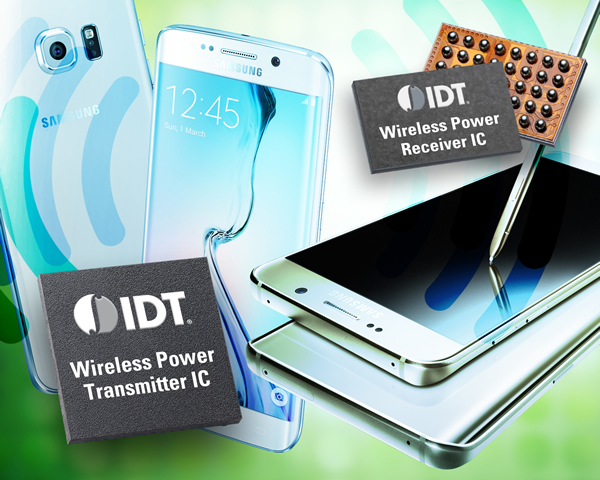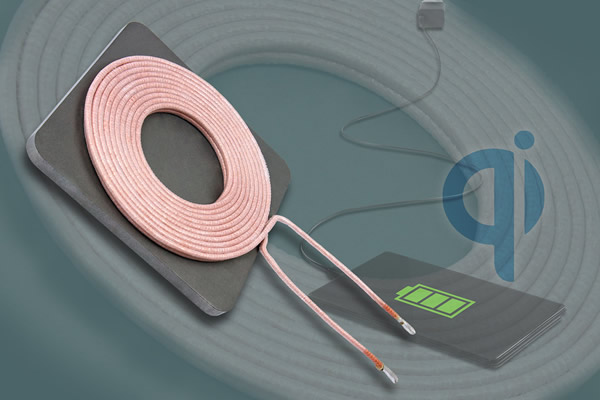The changing landscape of wireless charging
Developments in the rapidly evolving wireless charging market are improving the technology’s speed and efficiency, but a confusing standards situation is still holding things back, writes Sally Ward-Foxton.
Wireless charging has been around for a long time, since Tesla first demonstrated wireless power transfer in 1891 by lighting electric lamps without wires. More recently, you will have seen magnetic inductive charging in electric toothbrush stands as far back as the mid 1990s. This same technology has been adapted for conveniently charging mobile device batteries without having to plug in and unplug them on a daily basis.
So how does wireless charging work? Energy is transferred between two coils of wire, a transmitter and a receiver. The transmitter coil is in the charger device, typically a charging mat or pad, which draws energy from the mains. An AC current through the transmitter coil creates a changing magnetic field (magnetic flux), and the receiver coil in the mobile device is physically placed within this magnetic flux so that an AC current is generated in its windings, which is converted to battery voltages. When charging is complete, the mobile device communicates this separately to the charging pad to avoid overcharging.
How effective the energy transfer is depends on several factors, including coupling factor, which is a measurement of how much of the magnetic flux from the transmitter reaches the receiver. Coupling factor depends on the relative size, spacing and alignment of the two coils and is expressed as a figure between 0 and 1 (in practice it’s typically between 0.3 and 0.6). Charging schemes that require a high coupling factor are said to be tightly coupled, and those that allow a lower coupling factor are said to be loosely coupled. Since with tightly coupled coils, more magnetic flux reaches the receiver, this is a more efficient set-up.
However, loosely coupled charging schemes can improve their efficiency by using the principle of magnetic resonance. Resonant circuits are used in the transmitter and receiver - essentially, capacitors are added to cancel out stray inductances so that the resistance of the coils is the only impedance that limits power transmission. Coil resistance is usually one or two orders of magnitude less than the inductances, so efficiency is greatly improved. Unfortunately, due to the physical principles at play, tightly coupled coils by definition cannot both be in resonance, so charging schemes have to use one method or the other.
Standards emerging
With two separate technologies available for wireless charging, it was inevitable that standards for both would emerge. In fact, the standards landscape is still evolving - there are two main organisations but the situation is still relatively complex.
The Wireless Power Consortium (WPC) is promoting its magnetic inductive standard called Qi, which uses tightly coupled coils. In order to ensure good coupling, Qi coils often come with a magnet in the centre of the transmitter coil which forces the device on the charging mat to orient itself in the correct way to ensure efficient charging. Qi products have been deployed since 2008 and represent the biggest market share to date. To make things more confusing, Qi added resonance charging as an extension to its spec in early 2015 (called ‘Shared Mode’) to allow more separation between the coils so pads can be built into furniture, and more than one device to be charged simultaneously.
On the other side are the Power Matters Alliance (PMA), with its magnetic inductive standard (also called PMA, not compatible with Qi), and the Alliance for Wireless Power (A4WP) with its yet to be released Rezence standard for magnetic resonance charging. These two bodies merged in 2014 and now call themselves AirFuel - the two technologies are not interoperable but the new alliance is said to be working on a multi-mode standard, which will keep the name Rezence. AirFuel are promoting magnetic resonance technology as the way forward, since it allows charging multiple devices from one transmitter, greater separation of the coils (so it will work through furniture) and improves user friendliness since exact alignment isn’t needed.
Charging silicon
Can we expect to see Rezence products on the market any time soon? “Magnetic induction is moving forward faster, but will be followed by Rezence products hitting store shelves,” said Graham Robertson, VP Corporate Marketing at IDT. “IDT has been involved in this standard since about the start, and we continue to actively work on this evolving technology,”
IDT currently offers Qi and PMA transmitter and receiver chips (Figure 1). These power management ICs are required to convert AC from the receiving coil and rectify it to DC at a certain voltage, typically 5V, as well as provide communication and control circuitry to manage the charging process. They may also provide features such as foreign object detection, which raise the alarm if a metallic object is placed on the charging mat once charging has been initiated.
“We also make dual-mode devices that are currently on store shelves,” Robertson added. These 5W Qi and PMA devices can switch between the two standards automatically. “It provides flexibility for consumers - no matter which type of magnetic induction device a consumer buys, it will work with the charger if one or the other is dual mode.”
Dual mode devices also help ease inventory as OEMs can use one part number and a single BoM to support both standards.

Figure 1. IDT recently teamed with Samsung to deliver wireless charging for its Galaxy 6 edge+ and Galaxy Note 5 smartphones, Galaxy S6 wireless charger and Samsung Gear S2 smartwatch charging pad.
Coil efficiency
Aside from topology (tight coupling or resonance), wireless charging system efficiency also depends heavily on the quality of the coils used. Alan Jermyn, VP European Marketing at Avnet Abacus, explains that coils are typically specified by their quality factor (Q), which is proportional to operating frequency and inductance, and inversely proportional to its equivalent series resistance (Figure 2).
What kind of efficiency are today’s high end coil products capable of? “65% to 70%+ is typical,” Jermyn said. “As an example, Vishay’s Qi-compliant IWTX-4646BE-50 transmitter coil has a Q of 185. When combined with the company’s IWAS-4832FF-50 receiver coil with Q of 30, at 2.7mm spacing with 19V input voltage, efficiency is greater than 70%.”
“When choosing a wireless charging standard for your application, you’ll want to consider which one fits your application best,” Jermyn added. “Have a look at the trade-off between efficiency, EMI, horizontal and vertical freedom of alignment, and whether multiple devices will be charged simultaneously from one base station.”

Figure 2. The Vishay IWTX-4646BE-50 Qi transmitter coil. Avnet Abacus offers wireless charging coils from Abracon, TDK and Vishay.
Overall, although wireless charging is still significantly slower and less efficient than a simple wired connection, it offers a level of convenience which will be attractive to a lot of consumers. It adds cost to the device BoM but helps durability since tiny connectors, which can be mechanically weak after thousands of mating cycles, are no longer relied on to charge the device. In the future, charging points in public places such as cafes will become the norm, and automotive manufacturers will look to add wireless device chargers in their vehicles. Some automotive Tier 1s have even been looking into charging their electric cars’ batteries this way, though charging at those power levels is still further into the future. The technology is improving rapidly, but the standards ecosystem is still unnecessarily complex, especially since both sides effectively support both technologies now. For consumer acceptance the story needs to be clearer and simpler, so wireless charging will never be completely commonplace until either one standard wins or the two become interoperable, which could be some time yet.










